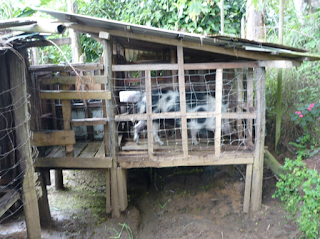1. Rudyard Kipling meets Indiana Jones with modest risk. The author's mini bio.
 |
| The author and refugee from a storm in Ocean Grove, Victoria, Australia. |
The postings in this blog series describe my endeavours with my colleagues John Cook and the late Liam Flanagan, in association with Business for Development, Oil Search Limited and a committed staff at Farm Alstonia, Port Moresby, to run a trial and set up a commercial pig production project near Nogoli, in Hela province, Papua New Guinea.
I’d been to PNG before, as a student in 1971 at the end of my second last year at vet school. The chance of easy global travel was becoming real for many students. I was a scholarship student from Mildura and my travel then was constrained by funds. Conveniently, because it was close and the travel costs relatively low, PNG was high on my list largely because it was very different to other places and I could afford the fare. It also featured prominently in my father’s life in the second world war. He served in a RAAF wireless eavesdropping unit. Together Dad and I had an on and off affair with PNG stretching from 1943 until 2016.
I’d specialized in pig medicine and production working mostly
in university, government agency and research sectors but I’d spent the last 14
years building my own consulting business. In that time, I’d worked on animal
health and production projects in the developing world for the FAO and ACIAR in
Thailand, Laos, Vietnam, Africa and East Timor. More recently I’d
worked in Lae with the Australian Centre for International Agricultural
Research (ACIAR) facilitating a meeting between Australian and PNG researchers
to develop an animal health research project.
The projects in Laos and
East Timor involved animal health and production and ways of feeding protein
supplements and balanced diets. In Laos, villagers used the legume
leaf crop stylo to feed pigs to great advantage. In East Timor I tried to use
balanced diets to improve growth rates in pigs. One of the things a veterinarian
must do is to identify where disease is causing a problem, where the problems
are independent of disease and where there is a mix of the two. I was seriously
into raising animals for people to eat. And I was drawn into the fascinating
web of the developing world. At the age of 16 I'd decided my career lay in agriculture. Like my father, grandfather and great- grandfather I would be part of producing food but I would do it as a vet. And with people for whom food security was a life or death matter.
 |
| The author's "inheritance" 1971, a Toyota and staff near Erap. |
1971-2 was not long before PNG gained independence in 1975. Michael Somare led the Pangu Party. His image was on posters everywhere. PNG was a country going places. For a young man then, it was Rudyard Kipling meets Indiana Jones – pure adventure but with little risk. In 2012 only the level of personal risk had changed. The knowledge and challenge adventure remained.




Comments
Post a Comment